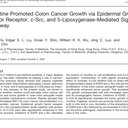
Binlong YeThe University of Hong Kong | HKU · Department of Earth Sciences
Binlong Ye
Doctor of Philosophy
Martian Geology | Minerals | Astrobiology | Spectrosocpy
About
16
Publications
3,649
Reads
How we measure 'reads'
A 'read' is counted each time someone views a publication summary (such as the title, abstract, and list of authors), clicks on a figure, or views or downloads the full-text. Learn more
155
Citations
Introduction
I employ interdisciplinary innovative technological tools, including the applciations of machine learning and remote sensing to characterize the geomorphology, minerlaogy and geochemistry of Mars and the Moon to understand the evolution of geology, climate and habitability of terrestrial planets. You can reach me through my email address binlongy@connect.hku.hk.
Skills and Expertise
Publications
Publications (16)
Ferrihydrite, a nanocrystalline iron (oxyhydr)oxide mineral, is widely distributed in soils and sediments on Earth and is probably an important component and/or precursor of widespread nanophase iron minerals on Mars. Terrestrial ferrihydrite often co‐occurs with amorphous silica and/or contains a certain amount of Si in its structure. However, it...
Clay minerals, or analogously phyllosilicates, are some of the most astonishing minerals ever discovered on Mars due to their roles as indicators of water-rock interaction. Their types, abundances, and locations provide hints to ancient environmental conditions of Mars and to the possible places where present-day mineral-bound water and/or biosigna...
Context. Olivine responds to space weathering in the fastest and most profound way, which results in significant space weathering spectral alteration effects (SWSAEs) on airless silicate bodies. Although Mg-rich olivine (Fa 10 ) has been subjected to extensive studies, SWSAEs of Fe-rich (Fa# > 20) or Fa-dominant (Fa# ⩾ 50) olivine are still poorly...
Young lunar mare basalts are recent volcanic products distributed mainly in the Procellarum-KREEP-Terrane. However, these young basalts were never investigated in situ until 2013 by Chang’e-3, and then sampled by Chang’e-5 in 2020. Using the returned Chang’e-5 samples as ground truth, and examining Moon Mineralogy Mapper data globally, we found the...
Chemical weathering profiles on Mars which consist of an upper Al clay-rich, Fe-poor layer and lower Fe/Mg clay-rich layer are believed to have formed due to precipitation-driven top down leaching process in an ancient, reducing greenhouse climate. Here we use remote sensing imagery and spectroscopy coupled with topographic data and crater chronolo...
On May 15, 2021, Tianwen-1's rover Zhurong landed successfully at 109.926°E, 25.066°N, in southern Utopia Planitia on Mars. The Zhurong landing site contains a wide range of geomorphic exploration targets including troughs, raised ridges, pitted cones, mesas, sand dunes and crater ejecta. Aspects of all of these features suggest formation through i...
Chang'e-5 successfully returned ?1,731 g of lunar samples on December 17, 2020. We systematically studied the morphology and morphometry of craters surrounding the Chang'e-5 site based on high-resolution images. A key ejecta source crater database was produced, incorporating their morphometrical parameters, excavation depth, target rock types, and...
Reduced greenhouse gases such as methane (CH4) and hydrogen (H2) might be the only tenable solution to explain warming of the ancient Martian climate, but direct geological evidence that a reduced atmosphere actually existed on Mars has been lacking. Here we report widespread, strong Fe loss in chemically weathered bedrock sections in the Mawrth Va...
Compositional stratigraphy, generally composed of Al-rich clay minerals overlying Fe/Mg-rich clay minerals, is observed in many locations on Mars. Here we describe the occurrence of such mineralogical stratigraphy in settings where the protoliths are almost certainly pyroclastic materials. One such example includes altered rocks high on the summit...
Over 600 chloride-bearing deposits (chlorides) have been identified on the southern highlands of Mars. These chlorides have critical implications for hydrology and astrobiology: they are indicators of an evaporating super saturated solution, and they could have provided habitat environments for halophilic microorganisms and preserved organic matter...
Yardangs are wind-eroded ridges usually observed in arid regions on Earth and other planets. Previous geomorphology studies of terrestrial yardang fields depended on satellite data and limited fieldwork. The geometry measurements of those yardangs based on satellite data are limited to the length, the width, and the spacing between the yardangs; el...






































































